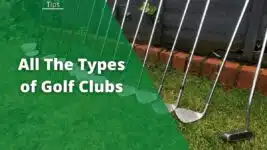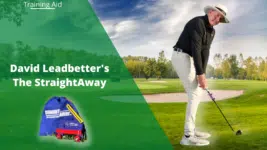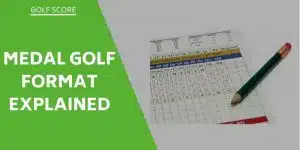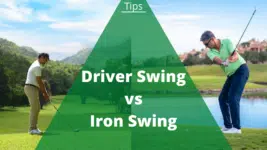Alignment is critical to your setup. No matter how good your swing and compression of the golf ball are, you are unlikely to get the golf ball close to the target without proper alignment. Getting your alignment sorted out will positively impact your ability to make birdies and par scores.
Alignment sticks are versatile training aids that can identify and assist in rectifying several swing mechanics, such as posture, backswing, downswing, and impact zone. To help with that, several alignment stick drills will help you train your technique effectively.
Here are the 10 best golf alignment sticks drill:
- Target Line Gate
- Narrow Path Drill
- Train Tracks Drill
- Weight Shift Alignment Stick Drill
- Downward Strike Drill
- Upper and Lower Body Alignment Drill
- Chip Without Flip
- Downward Strike for Chipping
- Putting Path Drill
- Putting Distance Control
You only need a few of these to improve, but not every drill will be right for you. Save time by reading thru all the drills so you understand the pros and cons of each. Then give a few a try!
This article will cover:
- How using golf alignment sticks can help your game
- The proper setup and use cases of alignment sticks
- Popular alignment stick golf drills
- Some helpful tips to improve your alignment
There’s a lot to break down with each of these topics. Keep reading to get all the details.
What Are Golf Alignment Sticks?
It’s common to take a few practice swings and get prepared for your shot. Golf alignment sticks can be a helpful part of that process. Alignment sticks are long, thin rods that you can place on either side of the ball or alongside your feet. They are often used when performing practice swings to help get the right stance and aim.
You can use them during practice swings and implement alignment stick drills during training. Drills can be helpful whether you’re out on the range or putting green. They’ll help you learn how to hit straighter shots and get the ball where you want it to go.
How To Use Alignment Sticks in Golf
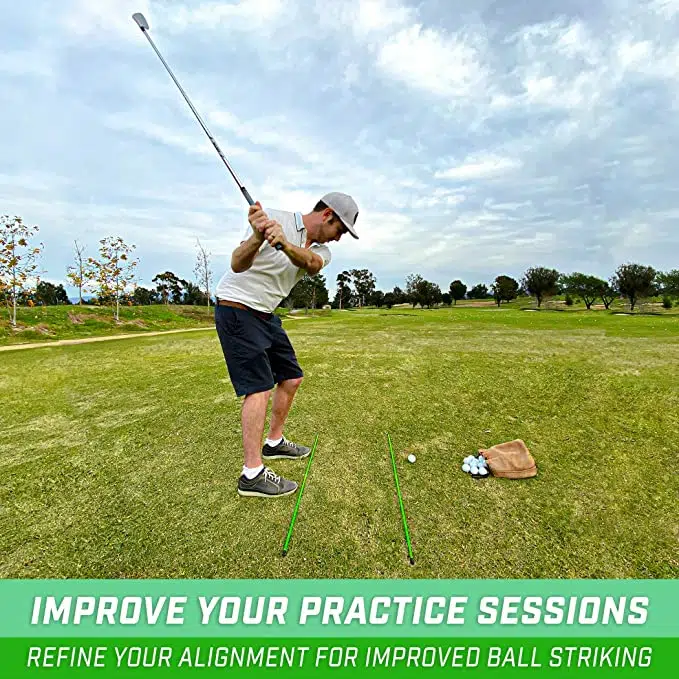
Before going out and doing alignment stick drills, you’ll want to learn how to use them properly. After all, practicing the wrong way can lead to even more bad habits.
Some tips for using alignment sticks correctly are:
- Set alignment sticks so they are pointing toward your target.
- In most instances, alignment sticks should be parallel to each other. They’re meant to form two lines to help you get the correct angle.
- Study the drill you’ll be doing. Specific alignment for each drill can vary, and it’s important to do each one the right way.
- Practice what you’re struggling with the most. If you’re having trouble putting, then do putting alignment drills. If you’re slicing the ball a lot, then doing anti-slice drills will be the best for you.
Keeping these aspects in mind will help you get the most out of training, and having some favorite drills will help you even more.
The 10 Best Golf Alignment Sticks Drills
Now that we have the basics down, let’s look at some specific drills that will improve your golf game.
1. Train Tracks Drill
Slicing the ball can be a common problem in golf. In fact, about 60% of golfers struggle with slicing their shots. This is when your shot curves right if you’re right-handed and left if you’re left-handed. The train tracks drill is one of the most popular golf alignment drills to prevent slicing.
The setup for this one is like the narrow path drill. However, this time the sticks are much further apart. You’ll want to put one stick about an inch away from your feet and parallel to your body. The second stick will go about 2 inches above the ball’s position.
The point of this drill is to create a visual of the train tracks while you’re swinging. You want to think about swinging straight through and sending the ball toward where the train tracks would continue.
2. Target Line Gate
This is one of the most common swing path drills with alignment sticks. It’s one of the few drills where the sticks aren’t placed parallel to each other.
Instead, you put one alignment stick on either side of the ball in the same path. So if you’re standing and facing the ball, one stick would be on the direct left of the ball, and the other would be on the direct right. You’ll want to leave eight inches of space on either side to still have room to swing. And both sticks should be pointing directly at the target.
For this drill, you’ll want to use the sticks to visualize a straight line as you swing. Start by looking at the sticks on the ground as you begin your swing. Visualize bringing your club straight back in line with the back stick. Then think about swinging straight through the second stick before the ball.
Also, remember to follow best practices for your golf backswing, like maintaining a firm grip and getting a full shoulder rotation while doing this drill.
3. Downward Strike Drill
Working on your downswing is important. Studies on golf swing biomechanics have shown that the downswing is one of the most critical parts of your form for performance. The downward strike will help you improve this crucial portion of your game. It will help you achieve a better impact that maximizes ball flight.
For this one, you want to lay one stick on the ground one inch behind the ball. The stick should be pointing in the direction of your target.
The key here is to ensure you don’t hit the stick when you follow through. Not hitting the stick shows that you’re making a solid impact on the ball.
4. Narrow Path Drill
Another popular swing path drill is called the narrow path drill. It should have a similar effect to the previous one, using a different visual.
For this one, you’ll want to have the sticks parallel to the ball, pointing in the direction of your target. The key to this one is creating a narrow path where each stick is only one inch away from the ball on each side.
During this drill, you’ll visualize keeping your club in line with the narrow path as you swing. It’s a very small swing plane, so this one is less forgiving. But it’ll force you to be very strict in your alignment.
5. Chip Without Flip
Many golfers can struggle with overactive hands and wrists on their chip shots. This can cause issues with the accuracy and velocity of your shots.
For this drill, you’ll place one alignment stick two inches in front of the ball. Make sure it’s pointing in the direction of your target.
Next, you’ll want to hold another stick toward the top of your club where you grip. Most of the rod should be sticking up above your club and off to the side of your body. When you swing, you’ll want to maintain good form and avoid having the stick touch your body.
6. Weight Shift Alignment Stick Drill
Another thing that can contribute to slicing is rotation. You’re more likely to slice the shot if you rotate your hips late or put too much weight into the trail foot.
The setup for this one is simple. You place one alignment stick on the ground just in front of your hip on your lead leg. Hit the ball and rotate through the angle of the stick. You aren’t rotating enough if your hip isn’t crossing the rod. You should also feel most of your weight on your lead leg at the end of the swing.
If you’re struggling with rotation, consider doing some of the best golf stretches to warm up before playing. Common ones that will help are standing oblique twists and a standing quad stretch.
7. Putting Path Drill
Accuracy is something we can all struggle with on the putting green. It seems simple, but like all other aspects of golf, there’s a mental game to it.
This one is similar to the train tracks drill. You’ll place alignment sticks on each side of the ball, pointing toward the hole. It’s best to start with straight putts with no slope to get the feel for it.
Once you’re making straight putts consistently, practice with different slopes to understand how to adjust your alignment accordingly.
8. Upper and Lower Body Alignment Drill
Another aspect that can affect impact is how your upper and lower body are aligned. For instance, if your feet are pointing in the wrong direction or your shoulders are too far open, you might not make clean contact.
For this drill, you’ll put one stick directly in front of your feet in your normal golf stance. Then you’ll hold another stick across your arms at chest height. You want to stand and align both sticks so they’re facing in the same direction. It should give you a feel for properly aligning when you set up and swing.
9. Putting Distance Control
You can also use drills to control your distance, which can be tough to estimate while putting.
You can perform this drill in two ways. The first way would be to place an alignment stick two feet behind the hole while doing long 15-20+ foot shots. The goal here is to ensure the ball doesn’t touch the rod if you miss the putt and go past the hole.
The second variation would be to place the rod two feet in front of the hole on long 15-20 foot putts. The goal here would be to hit putts just hard enough that they barely climb over the rod.
You can experiment with both variations to brush up on your putting game.
10. Downward Strike for Chipping
Many golfers can also struggle with making a solid impact on chip shots. This drill is essentially the downward strike covered earlier, just adjusted slightly for chipping.
Put one rod directly in front of your trail foot for this drill. It should be facing in the direction your foot is pointing. You want to avoid hitting the rod during your swing during the downswing. It’ll prevent too much drag, which is common with low chip shots.
Helpful Tips to Improve Your Basic Swing Alignment
Now that we’ve covered the golf alignment sticks drills, here are some additional tips to improve basic alignment.
Practice Good Posture and Rotation
Maintaining your posture throughout your swing is extremely important. Deviation in your posture will severely impact your alignment. Swaying away and toward the target will disrupt your swing, resulting in an inconsistent swing and strike.
To see whether you are standing up or bending too far over during your swing, place one of the alignment sticks across your shoulders and lay the second one on the expected swing path where the golf ball is positioned.
If your swing is too upright, the alignment stick will point outside of the alignment stick on the ground. If you bend too far over, the alignment stick will follow a path where the shoulders point to the inside of the alignment stick on the ground.
Revisit Alignment Drills Regularly
With practice, the alignment process becomes automatic, but it is still beneficial to revisit the process regularly to ensure that your alignment is correct. Practicing drills like train tracks or narrow path regularly are key ones to come back to frequently.
You can also experiment with different placements. For instance, some golfers prefer to place an alignment stick behind their heels on the train tracks drill.
This Michael Breed video will give you further insight into using golf alignment sticks.
A Narrower Distance Provides More Feedback on Your Swing Track
Narrowing the distance between the alignment sticks will provide quick feedback on your swing. This technique is used in the narrow path drill. If you strike either of the alignment sticks during your swing, it will provide a good indication that you are striking the ball off-center.
Ensure You Are Making Ball Contact First
To compress the ball for a pure strike creating additional spin and distance, you have to strike the ball first before generating impact with the turf. For this, you require proper weight transfer to move the bottom end of the swing arc a fraction of an inch forward during the downswing. Using the weight shift drill will help with this.
Get Feedback on Your Launch Direction
While doing exercises like the narrow path drill or target line gate, it can be helpful to get some feedback.
Take some practice swings to get the feel of the club moving toward the alignment stick. Once satisfied with the feel you can record your club and golf ball trajectory by placing a camera, or an observer, behind you to observe whether the golf ball takes off in the direction you want it to.
Putting
Putters with little or no toe hang require a straight-back, straight-through putting stroke, and alignment sticks are great training aids to ingrain this putting action. The more toe-hang in a putter, the more arced the putting stroke, and the less likely you will benefit from straight alignment aids.
Placing a golf ball in the center of the alignment stick will enable you to push it back parallel to the alignment stick and ensure that the follow-through of the putting strike remains straight and parallel to the alignment stick.
Chipping
Chipping requires stable wrists to prevent you from flipping through impact, thus losing distance and spin. To improve distance control, you can place two alignment sticks perpendicular to your body with approximately ½ yard between them. Try and land every chip between the two sticks from various distances.
FAQ
Do Golf Alignment Sticks Work?
Golf alignment sticks are an effective training tool. They will help create a visual for your shots and give some reliable feedback. Practice with them regularly to get the best results.
Do Pros Use Alignment Sticks?
The pros use alignment sticks frequently. Phil Mickelson is one of the pros who made using them more popular. Now you will frequently see several pro players warming up with them before a round.
How Do You Set Up Alignment Sticks for a Swing Path?
Keeping alignment sticks parallel and in the direction of your target is the best practice. Most players like putting one next to their feet and the other a couple of inches above the ball.
Final Thoughts
Overall, golf alignment stick drills can be very helpful in improving your golf game. Whether you’re struggling with swing path, rotation, making solid contact, or even your short game, the drills in this article can be used frequently in your practice sessions.
Don’t forget to come back to these drills regularly. Those living in areas with colder winters can be especially helpful to get back on track at the start of a new golfing season.
Now all that’s left to do is get out on the course and start practicing!
Related Articles
- How To Hit The Golf Ball Lower
- The Best Golf Tips To Improve Your Game
- The Best Golf Training Aids For Game Improvement in 2023
Nick is the founder of GolfSpan and an avid golfer. He's not quite a pro but has over 15 years of experience playing and coaching golfers worldwide. His mission is to bring the golfing community a better experience when it comes to choosing the right golf gear and finding the right setup for your game.

